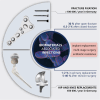Antimicrobial Biomaterials Based on Physical and Physicochemical Action
- PMID: 39301968
- PMCID: PMC11670291
- DOI: 10.1002/adhm.202402001
Antimicrobial Biomaterials Based on Physical and Physicochemical Action
Abstract
Developing effective antimicrobial biomaterials is a relevant and fast-growing field in advanced healthcare materials. Several well-known (e.g., traditional antibiotics, silver, copper etc.) and newer (e.g., nanostructured, chemical, biomimetic etc.) approaches have been researched and developed in recent years and valuable knowledge has been gained. However, biomaterials associated infections (BAIs) remain a largely unsolved problem and breakthroughs in this area are sparse. Hence, novel high risk and potential high gain approaches are needed to address the important challenge of BAIs. Antibiotic free antimicrobial biomaterials that are largely based on physical action are promising, since they reduce the risk of antibiotic resistance and tolerance. Here, selected examples are reviewed such antimicrobial biomaterials, namely switchable, protein-based, carbon-based and bioactive glass, considering microbiological aspects of BAIs. The review shows that antimicrobial biomaterials mainly based on physical action are powerful tools to control microbial growth at biomaterials interfaces. These biomaterials have major clinical and application potential for future antimicrobial healthcare materials without promoting microbial tolerance. It also shows that the antimicrobial action of these materials is based on different complex processes and mechanisms, often on the nanoscale. The review concludes with an outlook and highlights current important research questions in antimicrobial biomaterials.
Keywords: antimicrobials; bioglass; biomaterial associated infections; graphene; physical actions; proteins; switching.
© 2024 The Author(s). Advanced Healthcare Materials published by Wiley‐VCH GmbH.
Conflict of interest statement
The authors declare no conflict of interest.
Figures















Similar articles
-
Prevention of microbial biofilms - the contribution of micro and nanostructured materials.Curr Med Chem. 2014;21(29):3311. doi: 10.2174/0929867321666140304101314. Curr Med Chem. 2014. PMID: 24606506
-
Recent Advances in Collagen Antimicrobial Biomaterials for Tissue Engineering Applications: A Review.Int J Mol Sci. 2023 Apr 25;24(9):7808. doi: 10.3390/ijms24097808. Int J Mol Sci. 2023. PMID: 37175516 Free PMC article. Review.
-
Graphene-Based Composites for Biomedical Applications: Surface Modification for Enhanced Antimicrobial Activity and Biocompatibility.Biomolecules. 2023 Oct 24;13(11):1571. doi: 10.3390/biom13111571. Biomolecules. 2023. PMID: 38002253 Free PMC article. Review.
-
Antimicrobial Phenolic Materials: From Assembly to Function.Angew Chem Int Ed Engl. 2025 Mar 24;64(13):e202423654. doi: 10.1002/anie.202423654. Epub 2025 Feb 5. Angew Chem Int Ed Engl. 2025. PMID: 39905990 Review.
-
Piezoelectric materials for anti-infective bioapplications.J Mater Chem B. 2024 Nov 6;12(43):11063-11075. doi: 10.1039/d4tb01589d. J Mater Chem B. 2024. PMID: 39382208 Review.
References
-
- in Biomaterials science – An Introduction to Materials in Medicine, Vol. 1, 4th ed. (Eds: Wagner W. R., Sakiyama‐Elbert S. E., Zhang G., Yaszemski M. J.), Academic Press, Elsevier, Amsterdam, The Netherlands: 2020, p. 3.
-
- Juncker R. B., Lazazzera B. A., Billi F., J. Appl. Microbiol. 2021, 131, 2659. - PubMed
Publication types
MeSH terms
Substances
Grants and funding
LinkOut - more resources
Full Text Sources
Molecular Biology Databases

